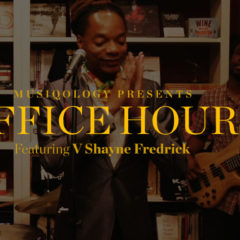“It took only 20 seconds for Clyde Stubblefield to drum his way to immortality.”
That lede, from The New York Times obituary for Stubblefield, who died on February 18 at the age of 74, was so perfect a summation of Stubblefield’s impact that we’ve taken a little creative liberty here, “sampling it” in the fashion in which Stubblefield attained his legendary status.
For the uninformed, Stubblefield was the eponymous “Funky Drummer” during a James Brown studio session in 1969, with The Hardest Working Man in Show Business counting him in, a driving four-count on the rim paired with a one-TWO on the snare. Unwavering despite Brown’s pleas to “bring on the juice,” Stubblefield’s persistent beat looped ad infinitum—a human drum machine driving Brown onward while lurking behind the horns and other instrumental flourishes.
“In short, there have been faster, and there have been stronger, but Clyde Stubblefield has a marksman’s left hand unlike any drummer in the 20th century,” Questlove said in 2011. “The thing that defines him, that sets him apart from other drummers, are his grace notes, which are sort of like the condiments of what spices up the main focus.” He added, “His grace notes, his softest notes, defined a generation.”
But by the 1980s, the “Funky Drummer” rimshots and snare hits were not soft any more. Blasting from boomboxes, Stubblefield’s sticks soundtracked a revolution, emerging as the ultimate breakbeat for the new sound. Radio Raheem was Stubblefield’s missionary, carrying his drumbeat through the Bed-Stuy streets as “Fight the Power” reworked the drums. Others would follow—Dr. Dre, Mos Def, N.W.A, LL Cool J, Nicki Minaj, Run-DMC, Eric B & Rakim, De La Soul, and even Sinéad O’Connor, Ed Sheeran, George Michael, and Kenny G(!) used the funky drummer’s beat. As far as the musical community is concerned, Stubblefield is generally understood to be the most-sampled drummer ever.
While his life should be celebrated and his musical legacy lives on through the stunning number of sounds he’s spawned, Stubblefield’s death is also a cautionary tale—Brown’s (understandable) desire to maintain creative control over his recordings paired with the still-uncertain sampling laws meant that Stubblefield saw little profit despite his seeming ubiquity. After Prince’s death, it was revealed that many of Stubblefield’s medical bills had been paid by the Minnesota artist, despite the two never having met.
The gift that Stubblefield gave music lives on, and we want to celebrate his life with a curated playlist—all of these songs, according to the fantastic website Who Sampled, contain Stubblefield’s beat. Those rimshots and snare hits will echo long after his unfortunate passing.

 Share On Facebook
Share On Facebook Tweet It
Tweet It








